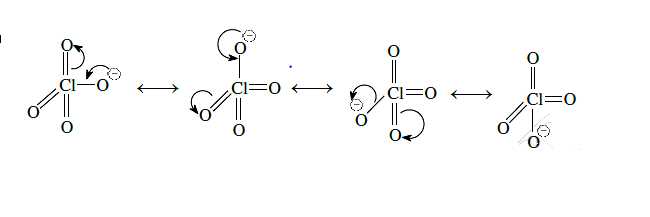The correct statement(s) about the oxoacids, $HClO_4$ and $HClO$, is(are)
- The conjugate base of $HClO _{4}$ is weaker base than $H _{2} O$
- The central atom in both $HClO _{4}$ and $HClO$ is $sp ^{3}$ hybridized.
- $HClO _{4}$ is more acidic than $HClO$ because of the resonance stabilization of its anion.
- $HClO _{4}$ is formed in the reaction between $Cl _{2}$ and $H _{2} O$.
The Correct Option is C
Solution and Explanation

$H _{2} O + Cl _{2} \rightarrow HCl + HOCl$
 undefined
undefined
^
Top Questions on p -Block Elements
Given below are two statements.

In the light of the above statements, choose the correct answer from the options given below:- JEE Main - 2025
- Chemistry
- p -Block Elements
Given below are two statements:
Statement I: Nitrogen forms oxides with +1 to +5 oxidation states due to the formation of $\mathrm{p} \pi-\mathrm{p} \pi$ bond with oxygen.
Statement II: Nitrogen does not form halides with +5 oxidation state due to the absence of d-orbital in it.
In the light of the above statements, choose the correct answer from the options given below:- JEE Main - 2025
- Chemistry
- p -Block Elements
Given below are the pairs of group 13 elements showing their relation in terms of atomic radius. $(\mathrm{B}<\mathrm{Al}),(\mathrm{Al}<\mathrm{Ga}),(\mathrm{Ga}<\mathrm{In})$ and $(\mathrm{In}<\mathrm{Tl})$ Identify the elements present in the incorrect pair and in that pair find out the element (X) that has higher ionic radius $\left(\mathrm{M}^{3+}\right)$ than the other one. The atomic number of the element (X) is
- JEE Main - 2025
- Chemistry
- p -Block Elements
- Thionyl chloride on reaction with white phosphorus gives a compound of phosphorus 'C' which on hydrolysis gives an oxo acid 'O'. The correct statements about C and O are
I. Shape of 'C' is pyramidal
II. 'O' is a dibasic acid
III. 'O' is a monobasic acid
IV. 'C' on reaction with acetic acid gives 'O'- TS EAMCET - 2025
- Chemistry
- p -Block Elements
- Which one of the following statements is not correct?
- TS EAMCET - 2025
- Chemistry
- p -Block Elements
Questions Asked in JEE Advanced exam
The center of a disk of radius $ r $ and mass $ m $ is attached to a spring of spring constant $ k $, inside a ring of radius $ R>r $ as shown in the figure. The other end of the spring is attached on the periphery of the ring. Both the ring and the disk are in the same vertical plane. The disk can only roll along the inside periphery of the ring, without slipping. The spring can only be stretched or compressed along the periphery of the ring, following Hooke’s law. In equilibrium, the disk is at the bottom of the ring. Assuming small displacement of the disc, the time period of oscillation of center of mass of the disk is written as $ T = \frac{2\pi}{\omega} $. The correct expression for $ \omega $ is ( $ g $ is the acceleration due to gravity):

- JEE Advanced - 2025
- Waves and Oscillations
- Consider the vectors $$ \vec{x} = \hat{i} + 2\hat{j} + 3\hat{k},\quad \vec{y} = 2\hat{i} + 3\hat{j} + \hat{k},\quad \vec{z} = 3\hat{i} + \hat{j} + 2\hat{k}. $$ For two distinct positive real numbers $ \alpha $ and $ \beta $, define $$ \vec{X} = \alpha \vec{x} + \beta \vec{y} - \vec{z},\quad \vec{Y} = \alpha \vec{y} + \beta \vec{z} - \vec{x},\quad \vec{Z} = \alpha \vec{z} + \beta \vec{x} - \vec{y}. $$ If the vectors $ \vec{X}, \vec{Y}, \vec{Z} $ lie in a plane, then the value of $ \alpha + \beta - 3 $ is ________.
- If $$ \alpha = \int_{\frac{1}{2}}^{2} \frac{\tan^{-1} x}{2x^2 - 3x + 2} \, dx, $$ then the value of $ \sqrt{7} \tan \left( \frac{2\alpha \sqrt{7}}{\pi} \right) $ is.
(Here, the inverse trigonometric function $ \tan^{-1} x $ assumes values in $ \left( -\frac{\pi}{2}, \frac{\pi}{2} \right) $.)- JEE Advanced - 2025
- Integral Calculus
Let $ a_0, a_1, ..., a_{23} $ be real numbers such that $$ \left(1 + \frac{2}{5}x \right)^{23} = \sum_{i=0}^{23} a_i x^i $$ for every real number $ x $. Let $ a_r $ be the largest among the numbers $ a_j $ for $ 0 \leq j \leq 23 $. Then the value of $ r $ is ________.
- JEE Advanced - 2025
- binomial expansion formula
- The total number of real solutions of the equation $$ \theta = \tan^{-1}(2 \tan \theta) - \frac{1}{2} \sin^{-1} \left( \frac{6 \tan \theta}{9 + \tan^2 \theta} \right) $$ is
(Here, the inverse trigonometric functions $ \sin^{-1} x $ and $ \tan^{-1} x $ assume values in $[-\frac{\pi}{2}, \frac{\pi}{2}]$ and $(-\frac{\pi}{2}, \frac{\pi}{2})$, respectively.)- JEE Advanced - 2025
- Inverse Trigonometric Functions
Concepts Used:
P-Block Elements
- P block elements are those in which the last electron enters any of the three p-orbitals of their respective shells. Since a p-subshell has three degenerate p-orbitals each of which can accommodate two electrons, therefore in all there are six groups of p-block elements.
- P block elements are shiny and usually a good conductor of electricity and heat as they have a tendency to lose an electron. You will find some amazing properties of elements in a P-block element like gallium. It’s a metal that can melt in the palm of your hand. Silicon is also one of the most important metalloids of the p-block group as it is an important component of glass.
P block elements consist of:
- Group 13 Elements: Boron family
- Group 14 Elements: Carbon family
- Group 15 Elements: Nitrogen family
- Group 16 Elements: Oxygen family
- Group 17 Elements: Fluorine family
- Group 18 Elements: Neon family